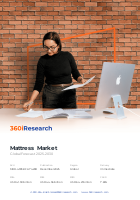
Mattress Market by Raw Materials (Airbed Chambers, Foam, Innerspring), Size (Double Size, King, Queen), Technology, Structural Design, Distribution Channel, Application - Global Forecast 2025-2030
SKU
MRR-437E8FA7420D
Region
Global
Publication Date
December 2025
Delivery
Immediate
2024
USD 41.30 billion
2025
USD 44.36 billion
2030
USD 64.21 billion
CAGR
7.63%

Download a Free PDF
Get a sneak peek into the valuable insights and in-depth analysis featured in our comprehensive mattress market report. Download now to stay ahead in the industry! Need more tailored information? Ketan is here to help you find exactly what you need.



